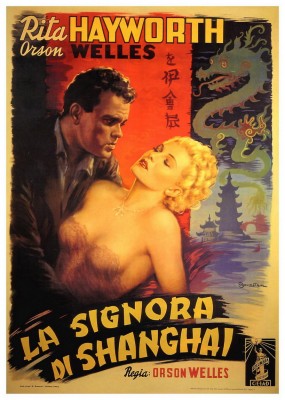| Reviews & Columns |
|
Reviews DVD TV on DVD Blu-ray 4K UHD International DVDs In Theaters Reviews by Studio Video Games Features Collector Series DVDs Easter Egg Database Interviews DVD Talk Radio Feature Articles Columns Anime Talk DVD Savant Horror DVDs The M.O.D. Squad Art House HD Talk Silent DVD
|
DVD Talk Forum |
|
|
| Resources |
|
DVD Price Search Customer Service #'s RCE Info Links |
|
Columns
|
|
|
Lady from Shanghai, The
I've seen Orson Welles's The Lady from Shanghai (1947) five or six times through the years, and still half the time I don't know what the hell is going on. Howard Hawks's The Big Sleep (1946) is a model of comprehensive linear storytelling by comparison. The Lady from Shanghai isn't nearly as good as Welles's Citizen Kane (1941), The Magnificent Ambersons (1942), Chimes at Midnight (1967) and a few others. It's not even Welles's best noir: Touch of Evil (1958) is far superior.
But it was produced, directed, stars, and was co-written by Welles, and those credentials alone make The Lady from Shanghai a film like no other, and it's still one of the greatest of film noirs. Top-billed Rita Hayworth, Welles's wife at the time, was Columbia Pictures biggest star. Studio head Harry Cohn felt Welles single-handedly had ruined this valuable commodity by cutting and dyeing Hayworth's famous red hair an icy blonde. The movie was a critical and financial disappointment, and Welles didn't get another shot at a major Hollywood studio for more than ten years.
However, like all of Welles's movies, The Lady from Shanghai's reputation has grown steadily through the years, partly for its justly famous house of mirrors shootout climax, but also because, well, the picture is just so damn enticingly weird.
Turner Classic Movies' "Vault Collection" label released The Lady from Shanghai on Blu-ray in January 2014, but apparently Sony/Columbia wasn't entirely happy with that release. The new reissue from budget label Mill Creek Entertainment (!) apparently sources a better 4K restoration, though unlike TCM's version offers no extra features. I didn't catch the TCM release but have seen the film several times in 35mm and this latest release plays like an optimized theatrical presentation.
The Byzantine plot concerns Irish sailor Michael O'Hara (Welles), who in New York's Central Park meets Elsa (Hayworth), the beautiful and well-traveled wife of celebrity defense attorney Arthur Bannister (Everett Sloane). Michael and Elsa flirt with one another, especially after he saves her from a trio of would-be muggers. She encourages him to work for him as a seaman aboard the Bannister's yacht, sailing the next day from New York, bound for San Francisco via the Panama Canal. However, when O'Hara finds a pistol in Elsa's handbag he senses that he's being set up as the fall guy for some nefarious, if nebulous, scheme, and begs off.
Nevertheless, he's persuaded to sign on, joining the Bannisters, their eccentric crew and passengers, including Bannister's law partner, George Grisby (Glenn Anders) and sailor-private eye-blackmailer Sydney Broome (Ted de Corsia). Over the course of their glamorous voyage O'Hara repeatedly tries to quit while Elsa continues flirting with O'Hara, something everyone seems fully aware of, including Bannister himself. Meanwhile, Grisby bizarrely offers O'Hara $5,000 to have the Irishman murder him.
After the fiasco/cinematic tragedy of It's All True (1941-42), Welles's reputation as a filmmaker was restored somewhat when his anti-fascist noir The Stranger (1946) became a hit. (Costing just over $1 million, it grossed $3.2 million.) From there Welles directed a musical stage adaptation of Around the World in Eighty Days and, as Welles tells it, desperately needed $55,000 for the release of its impounded costumes. Desperate for cash, he called Harry Cohn and, grabbing the pulp novel a girl working the box office was reading at the time, If I Should Die Before I Wake, sold the unread-by-Welles story to the studio.
However, this tale is almost certainly apocryphal, as future director William Castle, then under contract to Columbia as an assistant director, claimed that he, not Welles, had purchased the rights to the book, a more probable version of events.
Regardless, Welles did have the support of wife Rita Hayworth and the film was lavishly produced on location in Acapulco, Pie de la Cuesta, and San Francisco, though large portions of it were shot at Columbia, including much rear-projection process work. (There's even a clever bit of trickery involving a conversation between Anders and Sloane, the latter a projected image probably shot weeks earlier.)
When it was all assembled, reportedly running more than two-and-a-half hours, Cohn hated the film and vindictively ordered retakes and massive cuts, while completely ignoring Welles's notes about the film's score. Though Welles had delivered the film on time and on budget, studio tinkering pushed the film's cost far beyond what was originally planned and, of course, Welles got the blame.
As the alleged longer "director's cut" of the film no longer exists, if it ever existed at all, it's impossible to say whether that version would have been any more coherent, but in the end it hardly matters. The Lady from Shanghai is a delirious, dizzying exercise in style, its innovation stamped on every scene while the quick cutting helps make it play very modern today, if extremely weird and always off-kilter. Welles can't resist turning even standard movie scenes, like O'Hara's subsequent trial for capital murder, on its head.
The characters, to a one, are colorful and unforgettable, especially Anders' sweaty, unblinking apparent lunatic. Much of Welles's stock company is also present: Sloane, Mr. Bernstein from Citizen Kane, plays a character as far removed from that earlier performance as can be imagined, the crippled (and, by implication, impotent) conniving lawyer; Erskine Sanford has fun as a harried judge; Gus Schilling likewise as a sailor pal of O'Hara's; Harry Shannon and William Alland turn up as a cab driver and courtroom reporter, respectively.
Welles, whose directorial career always overshadowed his immense talents as an actor, gives a wonderfully nuanced, sardonic performance as O'Hara, complete with authentic Irish brogue. (Welles began his acting career at Dublin's Gate Theater.) His dialogue especially is rich with quotable lines, particularly this monologue that encapsulate the film's theme:
"Once, off the hump of Brazil I saw the ocean so darkened with blood it was black and the sun fainting away over the lip of the sky. We'd put in at Fortaleza, and a few of us had lines out for a bit of idle fishing. It was me had the first strike. A shark it was. Then there was another, and another shark again, 'till all about, the sea was made of sharks and more sharks still, and no water at all. My shark had torn himself from the hook, and the scent, or maybe the stain it was, and him bleeding his life away drove the rest of them mad. Then the beasts took to eating each other. In their frenzy, they ate at themselves. You could feel the lust of murder like a wind stinging your eyes, and you could smell the death, reeking up out of the sea. I never saw anything worse... until this little picnic tonight. And you know, there wasn't one of them sharks in the whole crazy pack that survived."
Hayworth is fine playing a classically icy noir femme fatale, though her acting really doesn't quite break through until literally her last moments in the film, maybe because by this point her true character has been revealed.
Anyway, it's secondary to the visual virtuosity and downright audacity of Welles's direction and the stunning cinematography of Charles Lawton, Jr. (and several others, including Rudolph Mate, uncredited). Highlights include the visual acrobatics of the courtroom scenes, and a suspenseful sequence in a Chinese theater where Welles the director focuses attention on the performers onstage, they nervously watching as police storm and search the theater in the middle of their show. (During this scene Hayworth's Elsa locates O'Hara via her fluency in Mandarin, cleverly established earlier.) Welles's hallucinogenic funhouse sequence was trimmed severely by Cohn, but enough of it remains to dazzle audiences.
Video & Audio
Sony's 4K restoration of The Lady from Shanghai, in its original black-and-white, standard 1.37:1 screen shape format, looks great, with lots of 1080p high-def detail and inky blacks. The 2.0 DTS-HD Master Audio (mono) is also fine, and supported by optional English subtitles. The disc is region A locked. No Extra Features.
Parting Thoughts
Don't try to figure out The Lady from Shanghai's plot. Better to sit back and enjoy director-producer-star Orson Welles's wonderful direction, cutting, and camerawork, which is wildly imaginative and exciting throughout. Though the disc lacks supplements, the transfer is excellent and the movie comes Highly Recommended.
Stuart Galbraith IV is the Kyoto-based film historian and publisher-editor of World Cinema Paradise. His credits include film history books, DVD and Blu-ray audio commentaries and special features.
|
| Popular Reviews |
| Sponsored Links |
|
|
| Sponsored Links |
|
|
| Release List | Reviews | Shop | Newsletter | Forum | DVD Giveaways | Blu-Ray | Advertise |
|
Copyright 2024 DVDTalk.com All Rights Reserved. Legal Info, Privacy Policy, Terms of Use,
Manage Preferences,
Your Privacy Choices | |||||||















